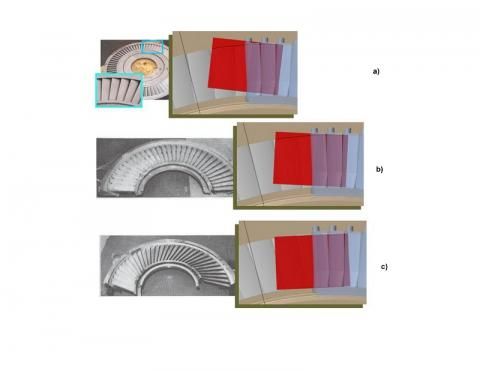Optimal tangential lean of vanes

A smooth and unimpeded steam flow entrance into the rotating blades, with proper distribution of steam along the heights of these blades, is one of the most substantial factors related to stage efficiency. Such a steam entrance is defined by the compound (axial and tangential) angle of the steam flow. The axial angle is achieved by the optimal vane airfoil design while the tangential angle depends upon the tangential vanes’ orientation (tangential lean).
Figure 1 shows the possible tangential leans of the vanes, the orientation of their exit edges and the direction of the steam flow provided by the following leans:
- Negative Lean
- Radial orientation (no lean)
- Positive Lean
Up until the 1970’s, the vanes were oriented with negative lean due to manufacturing limitations. As evident from Figure 1a, vanes with negative lean cannot effectively distribute the steam flow along the full height of the rotating blades. The peripheral area of the rotating blades is overloaded. Moreover, a significant portion of the steam flow is directed above the rotating blades, totally by-passing them. This is especially detrimental for designs without radial tip seals. Concurrent with the area of overload, some area at the root of the rotating blades experiences flow starvation. Such uneven steam flow distribution along the rotating blades significantly affects their efficiency and reliability.
In the period between the 1970’s and 1990’s continuous design and technological progress allowed the improvement of the vane positioning from a negative lean to a radial orientation of the vane exit edges. As seen in Figure 1b, this change resulted in a better steam flow distribution along the rotating blade height, which improved the efficiency and reliability. However, it did not completely resolve the problem.

Since the 1990’s further design and manufacturing improvements made it possible to develop the optimal tangential vane orientation with positive lean of the exit edges. Such vane positioning almost provides an even steam flow distribution along the entire height of the rotating blades in the high and intermediate pressure stages (Figure 1c). However, it is not enough for low pressure stages with long rotating blades. Only the latest 3-D design of the vane and blade airfoil areas (not shown here), resolves the problem for these low pressure stages. Figure 2 shows another view of the different tangential vane leans and their impact on stage efficiency, based upon R&D tests done in the former USSR and Japan. It is evident from Figure 2 that the implementation of the optimal vane tangential lean, as opposed to the vintage negative lean, results in an increase of stage efficiency within 1.0-1.5%.

Figure 3 shows actual diaphragms with negative and positive vane leans.